Nutricosmetics
New findings on food supplements for skin health
Gemma Casadevall1,2*
Javier Sala3*
Albert Sala4
*Corresponding authors
1. CEO - Nutraresearch, Hospitalet de Llobregat, Spain
2. Associate professor of pharmaceutical technology - University of Barcelona, Barcelona, Spain
3. Pilot Plant Manager - Nutraresearch, Hospitalet de Llobregat, Spain
4. R&D Director - Nutraresearch, Hospitalet de Llobregat, Spain
Irina Spacova1*
Arthur C. Ouwehand9*
Sylvie Binda2, Jessica A. Younes3,
Solange Henoud2, Sophie Legrain-Raspaud4,
James Dekker5, Jordi Espadaler-Mazo6, Philippe Langella7, Rebeca Martín7,
Marco Pane8
*Corresponding authors
1. Research Group Environmental Ecology and Applied Microbiology, Department of Bioscience Engineering, University of Antwerp, Antwerp, Belgium
2. Rosell Institute for Microbiome and Probiotics, Montreal, Canada
3. International Probiotics Association, California, USA
4. Gnosis by Lesaffre, Marcq-en-Barœul, France
5. Fonterra Research and Development Centre Co., Ltd., Palmerston North, New Zealand
6. R&D Department, AB-Biotics SA (Kaneka Group), Barcelona, Spain
7. Université Paris-Saclay, INRAE, AgroParisTech, Micalis Institute, Jouy-en-Josas, France
8. Probiotical Research, Novara, Italy
9. IFF Health & Biosciences, Kantvik, Finland


KEYWORDS
Skin
Supplements
Drug delivery
Beauty
Sustained release
Market trends
Abstract
Nutricosmetic formulations optimize the intake of nutritional elements to meet the demands of the skin, improving their conditions and delaying aging. The potential of natural products in the form of naturally derived cosmetics, cosmeceuticals, and nutricosmetics have, however, not been fully harnessed. This review, thus, analyzes the potential roles of natural products skin diseases due to the increasing consumers. Some of the most effective ingredients (like retinoids, peptides, and antioxidants) have become leading skin aging fighters in the industry. Vitamins (like B, C, and E), collagen, hyaluronic acid, coenzyme Q10, resveratrol are also among the industry’s staples. New market trends show the need to deliver food supplements with added value such as modified delivery systems help increase the absorption of ingredients that have a short shelf-life and poor bioavailability, thus reinforcing the reality of improving beauty from within the body.
The concept of nutricosmetics
Dietary supplements are intended to supplement the normal daily food intake of nutrients which are not ingested through a regular diet.
This is where the nutricosmetic concept appears. Nutricosmetics are defined in the intersection of nutrition and cosmetics (Figure 1). These nutricosmetic products improve not only the condition, appearance and aesthetics of human skin but also nails, and hair. These components in food supplements function as backbone nutrients that end up enhancing skin appearance thanks to the improving the total nutrients needed by our body (1).
Nutricosmetic formulations optimize the intake of nutritional macro and micro elements to meet the demands of the skin and appendages, improving their conditions and therefore delaying aging (2).
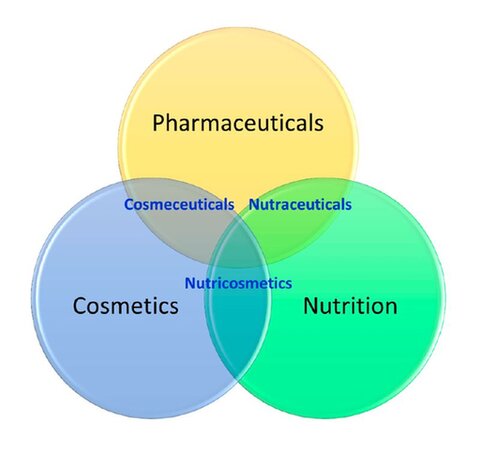
Figure 1. Types for natural self-care products: nutraceuticals, cosmeceuticals and nutricosmetics (3).
Skin market trends
In 2022, the beauty market—defined as skincare, fragrance, makeup, and haircare—generated approximately $430 billion in revenue. Today, beauty is on an upward trend across all categories. It has proven to be resilient amid global economic crises and in a turbulent macroeconomic environment. Beauty is now an industry that many people, from top-tier financiers to A-list celebrities, want to be a part of—and with good reason. Following a solid recovery since the height of the COVID-19 pandemic, the beauty market is expected to reach approximately $580 billion by 2027 (Figure 2), growing by a projected 6 percent a year (4).
According to the United Nations World Population Prospects 2019 report, the total population within the range of 40–59 years of age was approximately 17 million in 2019, and it is predicted to reach over 20 million by the year 2030. This age group population is anticipated to adopt preventive aging solutions (5).
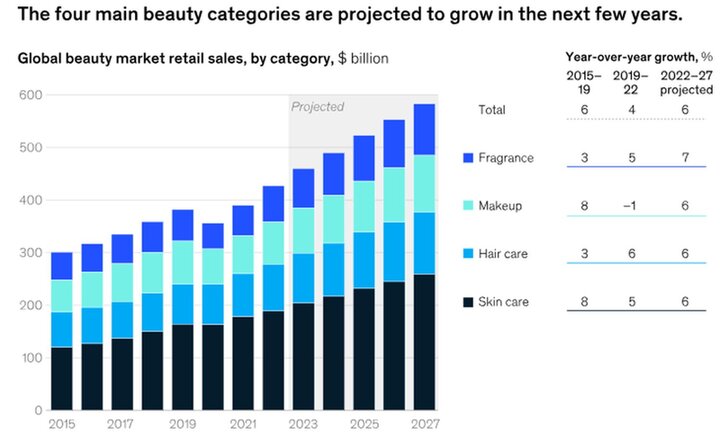
Figure 2. Global beauty market retail sales ($ billion). Source: McKinsey analysis; McKinsey Global Institute analysis (4).
Nutricosmetics vs Cosmetics
In general, the topical use of antioxidants and vitamins in cosmetics, cosmeceuticals, and nutricosmetics are known not only to protect the skin only better but also possibly to neutralize the damages of free radicals. Antioxidants and vitamins also play a significant anti-inflammatory role in stimulating collagen production, suppressing skin pigmentation, and bruising as well as refining keratinization. Nevertheless, issues like permeability, bioavailability, low water solubility, stability, rapid catabolism, and excretion as well as ingestion efficiency are some of the challenges facing the application of natural products and their bioactives (6).
The convergence of food and cosmetics in the beauty industry is a major trend in recent years, gaining an enormous importance on consumer habits including diet, nutritional supplement intake, and food-based cosmetics. The benefit of ingesting supplements for a healthy lifestyle is gaining a growing impact in the consciousness of promoting beauty from within (Figure 3), moreover, “feeling healthy” and “looking good” are concepts much more overlapped.
Nutritional supplements improve skin structure and function thanks to their antioxidant protection, anti-inflammatory activity, photoprotection properties, collagen synthesis and skin cell turnover. The advantage of oral supplementation is based on the dietary ingredient’s delivery to all skin layers (7).
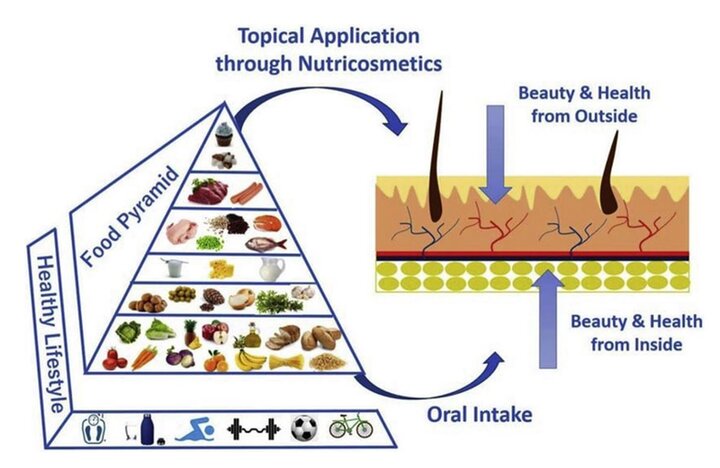
Figure 3. Action of food supplements from the inner level of the skin (7).
Key skin functional food supplements
Oxidative stress and inflammation mostly contribute to aging and age-related conditions including skin aging. The potential of natural products in the form of naturally derived cosmetics, cosmeceuticals, and nutricosmetics has, however, not been fully studied. Herewith we have analyzed the main active substance trends:
1. Vitamins
Vitamins modulate multiple biological functions that influence skin health; they represent a substantial ingredient in several cosmetic products as they play a fundamental role as antioxidant agents capable of counteracting the formation of free radicals and support the endogenous antioxidant system that intervene both in cellular aging processes and in the development of certain skin pathological conditions. In fact, the use of vitamins in the dermatological field is not limited only to cosmetics as they can be used as therapeutic or preventive agents in some skin diseases (Figure 4).
Some Vitamins can produce favorable reactions on the skin. This is the case of niacin (Vitamin B3), which has been shown to increase collagen production and dermal elasticity and reduce inflammation, thus acting as an anti-aging nutrient. Retinol (Vitamin A) participates in epidermal differentiation, modulation of dermal growth factors, regulation of sebaceous gland activity, and suppression of androgen formation.
They can be also considered as an antioxidant defense barrier of the skin capable of eliminating free radicals (Vitamin E, Vitamin C, Vitamin B3).
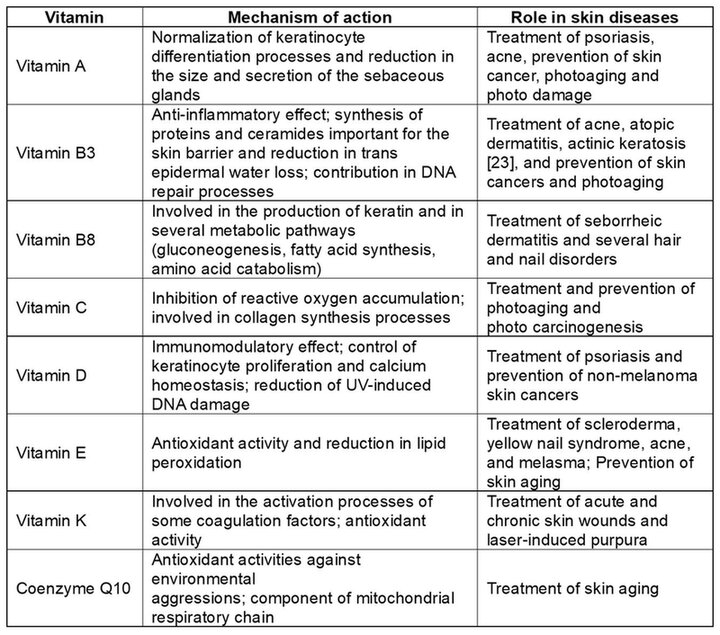
Figure 4. Summary of vitamin’s skin effects (8).
Furthermore, a deficiency in any of them can cause alterations in collagen production and a consequent increase in bone fragility, slower wound healing, capillary fragility, and the possibility of microbleeds (Vitamin C) (9). Vitamin E deficiency can cause keratosis and premature aging of the skin, difficulty in wound healing, impaired ability to concentrate, irritability, and impaired fertility. A biotin deficiency can have visible effects, such as hair loss or brittle nails. Additionally, enzymes depend on biotin to function, as it is important for energy production and helps the formation of fatty acids that nourish the skin (10). Therefore, taking a biotin supplement has positive effects on hair and nails.
2. Minerals
Minerals also play an important role in skin function. Some minerals are essential for the proper functioning of the skin, being a necessary element for epidermal and keratinocyte proliferation (Cooper & Zinc) (11). On the other hand, selenium promotes the elimination of harmful lipid hydroperoxides that form during oxidative stress and protects the skin against sun damage (12).
3. Fatty acids
Essential fatty acids are long chain polyunsaturated fatty acids being divided in omega 3 (derived from linolenic acid) and omega 6 (derived from linoleic acid).
These ingredients can reduce UV-induced inflammation; contribute for cell membranes’ structure, flexibility, and functioning, being involved in the synthesis of intracellular lipids in the stratum corneum and powerful skin regenerators (13).
4. Pre, Pro and Postbiotics
Research suggests that certain probiotic strains and their metabolites (postbiotics) may provide benefits such as improving the skin barrier function, reducing inflammation, and improving the appearance of acne prone or eczema prone skin. Consequently, in recent years probiotics and postbiotics have become popular ingredients in skincare products.
Moreover, it was demonstrated that skin health can be influenced by the skin gut axis, and imbalances in the gut microbiome caused by poor diet, stress, or the use of antibiotics can lead to skin conditions. Two examples can be:
- Lactobacillus acidophilus: effectively inhibited the wrinkle formation induced by UVB irradiation, and that this may be attributed to the downregulation of MMPs. Therefore, tyndalized L. acidophilus may be considered a potential agent for preventing skin photoaging and wrinkle formation (14).
- Bifidobacterium species: oral administration attenuates UV-induced barrier perturbation and oxidative stress of the skin, and this antioxidative effect is not attributed to enhancement of antioxidant capacity but to the prevention of reactive oxygen species (ROS) generation (15).
5. Plant Origin ingredients
Phytotherapy also plays an important role in the activity of the skin. There are plants with activity on the skin that are used to treat some diseases, including dermatological disorders. Oral aloe vera (Aloe sp.) gel treatment enhances the increase in collagen protype I mRNA. Aloe sterols stimulated collagen production in human dermal fibroblasts (16). It has potent anti-photoaging activity by suppressing UVB-induced MMP overexpression and hyaluronic acid loss. Another example is Centella asiatica (L.) Urb. Some studies show that the extract increased cell proliferation and collagen synthesis at the wound site, as evidenced by the increase in the DNA, protein, and collagen content of the tissues of granulation (17). Faster and better collagen maturation and cross-linking were also observed. On the other hand, horsetail (Equisetum arvense L.) provides silicon, exerting an effect on the skin since the level of silicon in the body decreases with age, resulting in brittle nails and hair and less resistance to infections fungal and bacterial (18).
6. Other active substances
There are also other active substances capable of having a positive action on the skin. Numerous studies that support the effectiveness of collagen peptides and glucosamine (and its derivatives) in increasing skin hydration, elasticity, and wrinkles. Another of these active substances with action on the skin is elastin. The production of elastin in the body decreases significantly throughout life causing the damage to be unable to be adequately repaired and the skin gradually losing its elasticity (19). Oral administration of elastin found its place in anti-aging supplements for skin suffering from dryness, environmental stress, or irritation.
Carotenoids (such as beta-carotene, lycopene, lutein, and zeaxanthin) and coenzyme Q10 are the main antioxidants that protect the skin, reducing some visible signs of aging such as wrinkles and raised micro lines and improving skin smoothness.
Dosage form
If food supplements are specifically formulated to deliver the right ingredients when needed, they can be more beneficial to support self-care from inside out. The latest trends, and more exigent consumers are appreciating more and more the link between skin, hair & nails health and thus, aspect, by nurturing our body with the right bioactive ingredients.
- Pharmaceutical technology
By default, the route of administration of the food supplement is orally. Consequently, these food supplements may present challenges such: a short half-life of the active ingredient, poor bioavailability, low plasma concentrations and therefore, their elimination from the body may also be also rapid. All of this can lead to less efficacious treatments. There are several techniques that allow us to solve these problems, such:
- Protection of the Active Ingredient
Different delivery systems (such as emulsions, microencapsulation, microemulsions, microgels, phytosomes, liposomes, nanoliposomes, nanoemulsions, niosomes, nanoparticles, nanovesicles, solid-liquid nanoparticles and biopolymer-based nanoparticles) have been developed for the incorporation of natural or purified products, plant extracts to improve: bioavailability, stability, and solubility, as well as to control and protect the release profile of natural products in the gastrointestinal tract (20).
- Modified Delivery
Food supplement dosage forms may offer constraints that can be overcomed by sustained or controlled drug delivery systems, that help in maintenance of constant plasma drug concentrations and delay the release rate of an active (Figure 5).

Figure 5. Modified release dissolution profile (21)
- Controlled release tablets
Modified drug delivery systems help in achieving on demand plasma drug concentrations. As a result, the absorption of such ingredients that may have challenges such short lifetimes or may have poor rates of absorption or bioavailability can be enhanced.
Pharmaceutical technology applied into food supplements, represents a big challenge since most of the current literature on synthetic drugs cannot be translated as such given that most excipients are not able to be used under food supplements regulations, such as titanium dioxide, which is commonly used in the coating drug tablets is forbidden in the food sector.
Some active substances applied to the skin have short half-life times and low bioavailability (Figure 6). By administering modified-release tablets, the active substance can be administered progressively, and its effectiveness can be improved.
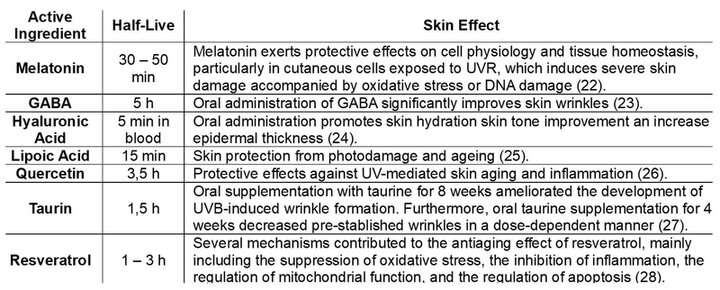
Figure 6. Summary of active substances skin effects.
For example, resveratrol has been reported to have antioxidant, anti-inflammatory, anti-aging, and neuroprotective properties, which can be relevant in chronic diseases and longevity in humans (29).
With a half-life of ca. 2h, resveratrol has a bioavailability, which is relatively low because of its rapid metabolism and elimination. Its extensive metabolism in the liver and intestine results in an oral bioavailability of less than 1% (23). Thus, given as an extended-release treatment our body may benefit much better from its properties given at the same dose (Figure 7).
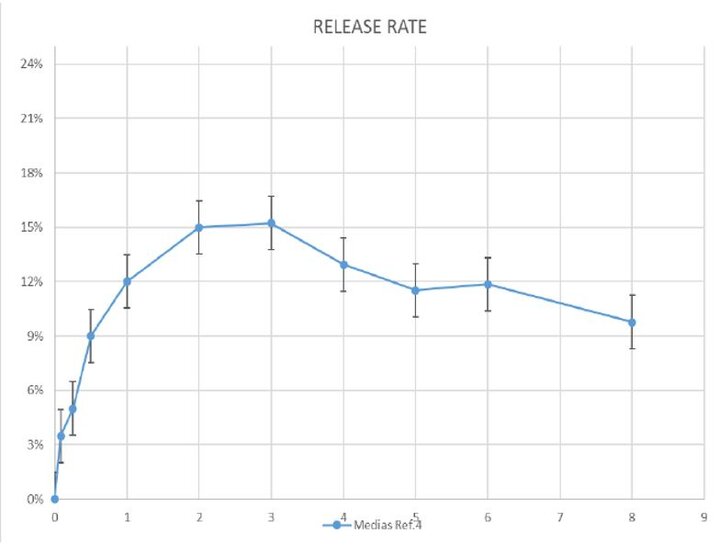
Figure 7. Release rate profile of resveratrol tablets.
Conclusions
Nutricosmetics can be described as the oral supplementation of nutrients by combining cosmeceuticals and nutraceuticals.
Some of the most effective ingredients (like retinoids, peptides, and antioxidants) have become leading skin aging fighters in the industry. Vitamins (like B, C, and E), collagen, hyaluronic acid, coenzyme Q10, resveratrol are also among the industry’s staples.
New market trends show the need of delivering food supplements with added value. Pharmaceutical technology plays an important role when it comes to the administration of these active substances. Sustained and controlled drug delivery systems help increase the absorption of ingredients that have a short shelf life and poor bioavailability. Thanks to these, food supplements administered as a controlled-release treatment can benefit much better from their properties administered at the same dose, improving their effectiveness.
The main challenge is related to the stability of such ingredients when out of their natural source and the maintenance of their bioactive properties once formulated. This is a renewed area of research requiring interdisciplinary investigation in fields such as biotechnology, food technology, pharmaceutical technology, and toxicology.



References and notes
- Usman R, Bharadvaja N. Nutricosmetics: role in health, nutrition, and cosmetics. Vol. 89, Proceedings of the Indian National Science Academy. Springer Nature; 2023. p. 584–99. https://link.springer.com/article/10.1007/s43538-023-00181-x
- Dini I. The Potential of Algae in the Nutricosmetic Sector. Vol. 28, Molecules. MDPI; 2023. https://www.mdpi.com/1420-3049/28/10/4032
- Wu Y, Choi MH, Li J, Yang H, Shin HJ. Mushroom cosmetics: The present and future. Vol. 3, Cosmetics. MDPI AG; 2016. https://www.mdpi.com/2079-9284/3/3/22
- Mckinsey & Company. The beauty market in 2023: A special State of Fashion report | McKinsey [Internet]. Mckinsey. 2023. Available from: https://www.mckinsey.com/industries/retail/our-insights/the-beauty-market-in-2023-a-special-state-of-fashion-report
- Aguilar-Toalá JE, Vidal-Limon A, Liceaga AM. Nutricosmetics: A new frontier in bioactive peptides’ research toward skin aging. Adv Food Nutr Res. 2023 Jan 1;104:205–28. https://www.sciencedirect.com/science/article/abs/pii/S1043452622000833?via%3Dihub
- Chermahini SH, Adibah F, Majid A, Sarmidi MR. Cosmeceutical value of herbal extracts as natural ingredients and novel technologies in anti-aging. Journal of Medicinal Plants Research [Internet]. 2011;5(14):3074–7. Available from: https://academicjournals.org/journal/JMPR/article-abstract/2EF5E9718861
- Faria-Silva C, Ascenso A, Costa AM, Marto J, Carvalheiro M, Ribeiro HM, et al. Feeding the skin: A new trend in food and cosmetics convergence. Vol. 95, Trends in Food Science and Technology. Elsevier Ltd; 2020. p. 21–32. https://www.sciencedirect.com/science/article/abs/pii/S0924224419305035
- Dattola A, Silvestri M, Bennardo L, Passante M, Scali E, Patruno C, et al. Role of Vitamins in Skin Health: a Systematic Review. Vol. 9, Current Nutrition Reports. Springer; 2020. p. 226–35. https://pubmed.ncbi.nlm.nih.gov/32602055/
- Pullar JM, Carr AC, Vissers MCM. The roles of vitamin C in skin health. Vol. 9, Nutrients. MDPI AG; 2017. https://www.mdpi.com/2072-6643/9/8/866
- Miller SJ. Nutritional deficiency and the skin. J Am Acad Dermatol. 1989 Jul 1;21(1):1–30. https://www.jaad.org/article/S0190-9622(89)70144-4/pdf
- Tenaud I, Sainte-Marie I, Jumbou O, Litoux P, Dré No B. In vitro modulation of keratinocyte wound healing integrins by zinc, copper and manganese. Vol. 140, British Journal of Dermatology. 1999. https://academic.oup.com/bjd/article-abstract/140/1/26/6691518?redirectedFrom=fulltext&login=false
- Zhu X, Jiang M, Song E, Jiang X, Song Y. Selenium deficiency sensitizes the skin for UVB-induced oxidative damage and inflammation which involved the activation of p38 MAPK signaling. Food and Chemical Toxicology. 2015 Jan 1;75:139–45. https://www.sciencedirect.com/science/article/abs/pii/S0278691514004840?via%3Dihub
- Boelsma E, Hendriks HFJ, Roza L. Nutritional skin care: health effects of micronutrients and fatty acids. Am J Clin Nutr. 2001 May 1;73(5):853–64. https://www.sciencedirect.com/science/article/pii/S0002916523065978?via%3Dihub
- Im AR, Kim HS, Hyun JW, Chae S. Potential for tyndalized Lactobacillus acidophilus as an effective component in moisturizing skin and anti-wrinkle products. Exp Ther Med. 2016 Aug 1;12(2):759–64. https://www.spandidos-publications.com/10.3892/etm.2016.3406
- Ishii Y, Sugimoto S, Izawa N, Sone T, Chiba K, Miyazaki K. Oral administration of Bifidobacterium breve attenuates UV-induced barrier perturbation and oxidative stress in hairless mice skin. Arch Dermatol Res. 2014;306(5):467–73. https://link.springer.com/article/10.1007/s00403-014-1441-2
- Kaminaka C, Yamamoto Y, Sakata M, Hamamoto C, Misawa E, Nabeshima K, et al. Effects of low-dose Aloe sterol supplementation on skin moisture, collagen score and objective or subjective symptoms: 12-week, double-blind, randomized controlled trial. Journal of Dermatology. 2020 Sep 1;47(9):998–1006. https://onlinelibrary.wiley.com/doi/10.1111/1346-8138.15428
- Arribas-López E, Zand N, Ojo O, Snowden MJ, Kochhar T. A Systematic Review of the Effect of Centella asiatica on Wound Healing. Vol. 19, International Journal of Environmental Research and Public Health. MDPI; 2022. https://www.mdpi.com/1660-4601/19/6/3266
- Michalak M, Pierzak M, Kręcisz B, Suliga E. Bioactive compounds for skin health: A review. Vol. 13, Nutrients. MDPI AG; 2021. p. 1–31. https://www.mdpi.com/2072-6643/13/1/203
- Baumann L, Bernstein EF, Weiss AS, Bates D, Humphrey S, Silberberg M, et al. Clinical Relevance of Elastin in the Structure and Function of Skin. Aesthet Surg J Open Forum. 2021 Sep 1;3(3). https://academic.oup.com/asjopenforum/article/3/3/ojab019/6275566
- Ahmed IA, Mikail MA, Zamakshshari NH, Mustafa MR, Hashim NM, Othman R. Trends and challenges in phytotherapy and phytocosmetics for skin aging. Vol. 29, Saudi Journal of Biological Sciences. Elsevier B.V.; 2022. https://www.sciencedirect.com/science/article/pii/S1319562X22002790
- Ma WC, Lee JM, An J, Yeong WY. 3D Printing in Triggered Drug Delivery Devices: A Review. Biomedical Materials & Devices. 2023 Sep;1(2):720–30. https://link.springer.com/article/10.1007/s44174-022-00058-5
- Bocheva G, Slominski RM, Janjetovic Z, Kim TK, Böhm M, Steinbrink K, et al. Protective Role of Melatonin and Its Metabolites in Skin Aging. Vol. 23, International Journal of Molecular Sciences. MDPI; 2022. https://www.mdpi.com/1422-0067/23/3/1238
- Zhao H, Park B, Kim MJ, Hwang SH, Kim TJ, Kim SU, et al. The Effect of γ-Aminobutyric Acid Intake on UVB-Induced Skin Damage in Hairless Mice. Biomol Ther (Seoul). 2023;31(6):640–7. https://www.biomolther.org/journal/view.html?doi=10.4062/biomolther.2023.085
- Gao YR, Wang RP, Zhang L, Fan Y, Luan J, Liu Z, et al. Oral administration of hyaluronic acid to improve skin conditions via a randomized double-blind clinical test. Skin Research and Technology. 2023 Nov 1;29(11). https://onlinelibrary.wiley.com/doi/10.1111/srt.13531
- Matsugo S, Bito T, Konishi T. Photochemical stability of lipoic acid and its impact on skin ageing. In: Free Radical Research. Informa Healthcare; 2011. p. 918–24. https://www.tandfonline.com/doi/full/10.3109/10715762.2011.587420
- Shin EJ, Lee JS, Hong S, Lim TG, Byun S. Quercetin directly targets JAK2 and PKCδ and prevents UV-induced photoaging in human skin. Int J Mol Sci. 2019 Nov 1;20(21). https://www.mdpi.com/1422-0067/20/21/5262
- Yoshimura T, Manabe C, Inokuchi Y, Mutou C, Nagahama T, Murakami S. Protective effect of taurine on UVB-induced skin aging in hairless mice. Biomedicine and Pharmacotherapy. 2021 Sep 1;141. https://www.sciencedirect.com/science/article/pii/S0753332221006806?via%3Dihub
- Zhou DD, Luo M, Huang SY, Saimaiti A, Shang A, Gan RY, et al. Effects and Mechanisms of Resveratrol on Aging and Age-Related Diseases. Vol. 2021, Oxidative Medicine and Cellular Longevity. Hindawi Limited; 2021. https://www.hindawi.com/journals/omcl/2021/9932218/
- Robinson K, Mock C, Liang D. Pre-formulation studies of resveratrol. Drug Dev Ind Pharm. 2015 Jan 1;41(9):1464–9. https://www.tandfonline.com/doi/full/10.3109/03639045.2014.958753

